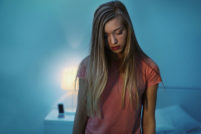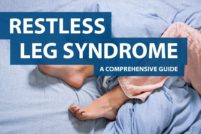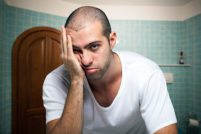Have you been told that you behave strangely when you sleep? Do you kick, punch, yell out or even jump out of bed?
Are you acting out your dreams?
For the majority of people dreaming is a completely internal experience, but in those with a sleep disorder called REM sleep behavior disorder dreaming becomes physical experience.
What Is REM Sleep Behavior Disorder?
REM sleep behavior disorder (RBD) is a condition that causes people to act out their dreams. You may move your limbs, talk or shout, and even jump out of bed.
When awakened, a person with RBD is usually able to remember the dream they were having in vivid detail and their movements during the night match its content.
Since all the action happens while you’re fast asleep, someone with RBD may not be aware of their condition until they’re either informed by a witness or suffer an injury.
What is REM Sleep?
Sleep is actually made up of three distinct stages: wakefulness, rapid eye movement (REM) sleep, and non-REM sleep. Over the course of the night you transition from one stage to another, each defined by a specific set of characteristics.
As hinted by it’s name, REM sleep behavior disorder occurs during REM sleep. During this stage we experience the majority of our dreams, and when observed the electrical activity of the brain reveals activity similar to that of being awake.
However, unlike in a waking state, the muscles throughout the body are temporarily paralyzed. This phenomenon is believed to occur in order to prevent exactly what we see in RBD: the physical acting out of dreams.
Over the course of the night you may have as many as four episodes of REM sleep, spaced about 1.5 to 2 hours apart. For this reason, the first signs of RBD appear at least 1.5 hours after you’ve gone to sleep, and increase towards the morning as the length of each REM stage increases.
Since you typically do not enter REM during a nap they’re not usually associated with RBD; and some people may only experience RBD rarely — as little as once per month.
During an episode, someone with RBD may:
- Flail their arms and legs
- Shout and swear
- Kick and punch
- Leap out of bed
- Jump around
These actions will all be associated with the content of the dream they are having during the episode. For example, if you dream that you are being chased you may jump up out of bed in order to escape your attacker. If there’s a struggle, you may punch and kick your legs in defense.
Unlike other sleep disorders, RBD rarely impacts the quality of your sleep and therefore isn’t associated with symptoms of sleep deprivation.
However, the same cannot be said for someone sharing your bed — bed partners of people with RBD often report experiencing significant disruption to their sleep.
What Causes RBD?
RBD is believed to be caused by a breakdown in the barrier between REM sleep and wakefulness. A similar phenomenon is observed in other parasomnias and sleep disorders like narcolepsy.
The result is that characteristics of one state leak into the other. Animal studies performed in the 1960’s revealed that lesions to the brain stem produced symptoms similar to those seem in RBD.
This region of the brain is necessary for the muscle inhibition seen in REM, and while an EEG recorded brain waves associated with REM sleep, cats with this lesion were observed performing a variety of behaviors.
However, unlike with the animals featured in these studies, science is still not clear on what causes the neurological barriers between the states of consciousness to fail in those with RBD.
Risk Factors Associated With RBD
RBD is far from a common condition: only 1% of the population are diagnosed with this sleep disorder. It most often affects men and typically emerges after the age of 50, and is rarely seen in women and children.There are certain medical conditions — particularly neurological disorders — that increase your risk of developing RBD:
- Parkinson’s disease
- Multiple system atrophy
- Lewy body dementia
- Narcolepsy
Additionally, some neurologists believe that RBD may be an early sign of neurodegenerative disease. A longitudinal study revealed that 38% of RBD patients went on to develop Parkinson’s disease a decade later.
The development of RBD has also been shown to be associated with conditions that lead to an increase in the intensity of REM sleep:
- Brainstem tumors
- Strokes
- Sleep deprivation
- Alcohol withdrawal
- Post-traumatic stress disorder (PTSD)
- Certain medications (sedatives, antidepressants)
If you have RBD, you may find that certain things can trigger your episodes or increase the severity of your symptoms. In short, anything that affects the quality of your sleep — particularly REM sleep — is liable to have adverse effects on your disorder.
Being sleep deprived, whether or not due to another sleep disorder, is one of the easiest way to provoke an episode. Other factors that may exacerbate your symptoms are alcohol, certain medications and stress.
Should I See My Doctor?
Anyone experiencing the symptoms of RBD should make an appointment with their doctor to discuss their symptoms. RBD is a progressive disorder — meaning that it gets worse with time — and it often appears alongside other medical problems.
Ensuring that your medical team is aware of your disorder is essential in not only treating RBD, but also for monitoring your health into the future.Your doctor will ask you in-depth questions regarding your symptoms, your medical history and that of your family. They’ll perform a physical exam and likely order blood tests to confirm your physical health.If your doctor suspects you may have RBD they will then refer you to a neurologist for a more thorough examination and to check for neurodegenerative disorders.
You may also see a sleep specialist and have tests for other sleep disorders, as RBD is often seen alongside sleep apnea, periodic limb movement disorder and narcolepsy.This video shows an RBD episode that was captured during an in-lab sleep study.
You will likely also be asked to keep a sleep diary both before and after your treatment has begun. This will provide your doctor with both a better understanding of your symptoms and how they are affecting your overall sleep, as well as allow them to see how you are responding to the chosen treatment.
How Is RBD Treated?
While most people require medication in order to keep their RBD symptoms in check you should also make certain lifestyle changes to improve your sleeping habits and protect against injury. Alongside specific treatments for your RBD, your doctor will also address any other sleep disorders that were uncovered during your diagnosis. Reducing the disruption to your sleep caused by these comorbid conditions helps to decrease symptoms of RBD.You will also have to have regular appointments with your doctor in order to check for any symptoms suggestive of a neurological disorder such as Parkinson’s. These include tremors, muscle rigidity and slow movements.
Medications
Several medications are effective in treating RBD, but by far the most widely used is the drug clonazepam. A member of the benzodiazepine family, clonazepam helps to inhibit muscle activity and promote relaxation while you sleep.
While clonazepam is successful in treating RBD 90% of the time, some people do not respond to this medication. In these cases antidepressants or melatonin supplements may be prescribed instead.
Doctors are cautious about the use of clonazepam in patients who also have gait disorders, dementia or obstructive sleep apnea, as it may aggravate these conditions.
Sleep Hygiene and Bedroom Safety
Practicing good sleep hygiene is essential for anyone suffering from a sleep disorder. Sleep hygiene simply refers to a set of lifestyle habits that promote healthy sleep, which have been proven to effectively reduce the symptoms of a variety of sleep disorders including RBD.
The main goal of sleep hygiene for RBD is to reduce the impact of sleep deprivation. You can learn more tips in our in-depth guide, but to start you should:
- Stick to a set sleep-wake schedule
- Avoid alcohol and caffeine before bed
- Ensure you get adequate sleep
Safety First
It’s recommended that anyone with RBD ensure that their sleeping environment is safe for both themself and their bed partner:
- Keep the area clearRemove all the objects and furniture from around the sides of the bed, especially those that can be broken or cause injury if thrown. Any particularly dangerous objects should be removed from the bedroom entirely.
- Lower your bedTo prevent the risk of hurting yourself by falling out of bed, switch to a low profile bed frame or ditch the frame entirely and put your mattress on the floor. If you’re particularly active during your episodes you may want to sleep on the ground floor of your home to avoid stairs.
- Use paddingCushioning the floor around the bed and padding hard surfaces like bedside tables and headboards can help reduce the risk of serious injury when trashing around in bed. You may even want to install padded bedrails to prevent you from getting out of bed.
Sources:
- https://sleepfoundation.org/sleep-disorders-problems/rem-behavior-disorder
- http://www.sleepeducation.org/sleep-disorders-by-category/parasomnias/rem-sleep-behavior-disorder/diagnosis-treatment
- http://www.medicalnewstoday.com/articles/247730.php





